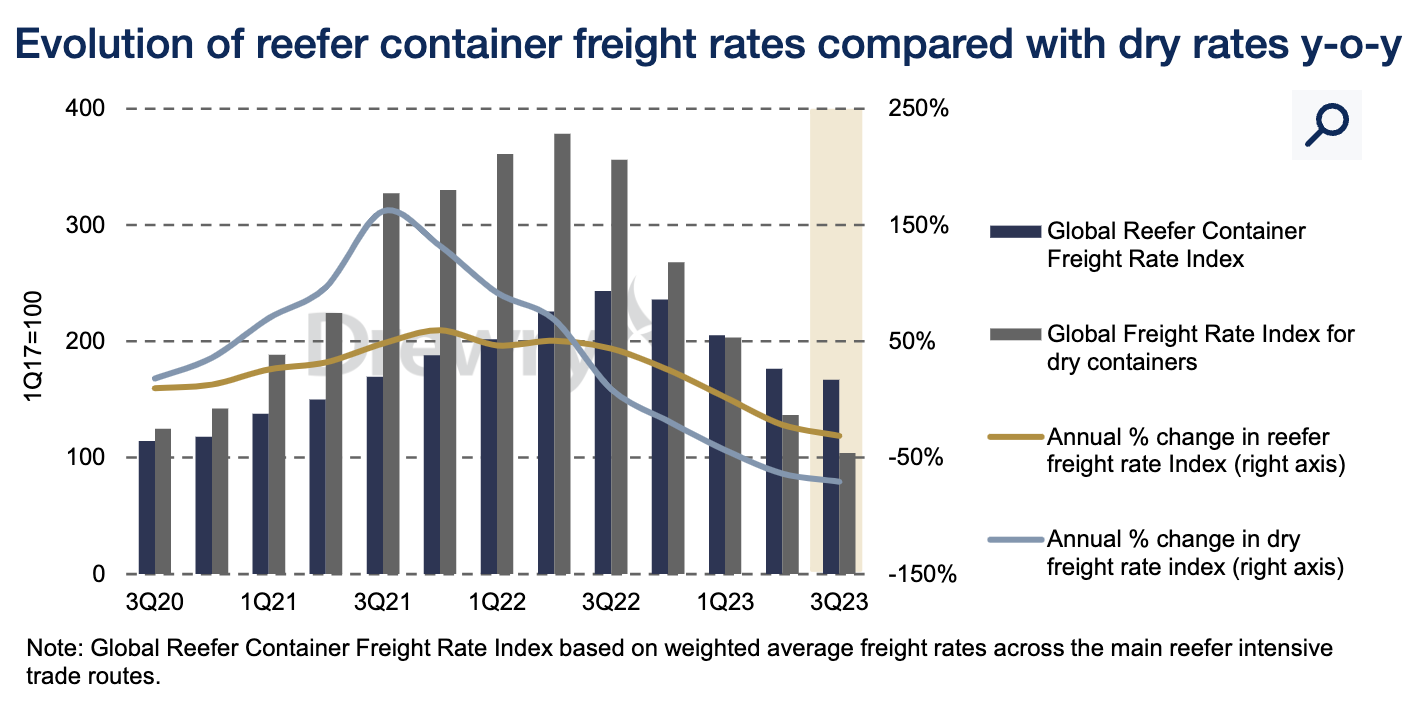
Reefer container freight rates continue to outperform the dry cargo trade, despite an unprecedented contraction in reefer seaborne trade last year, and this divergence is forecast to continue over the next few years, according to Drewry's recently published Reefer Shipping Annual Review and Forecast report.
The normalisation of the reefer trade and resultant freight rate correction has proved more gradual than for wider container shipping, and reefer cargo demand has been steadily recovering since the start of the year, demonstrating the resilience of the trade.
In the report, Drewry estimates that total worldwide seaborne reefer cargo declined to 137.5 million tonnes last year, representing a fall of almost 1%, the first time in over 20 years and compared to flatlining trade for dry cargo.
It added that supply chain disruptions, rising input costs and normalisation in perishables cargo demand after the peaks of 2021 all contributed to the decline.
Key reefer commodities such as meat, bananas and fresh vegetables all took a hit in 2022 as a result.
Drewry said containerised reefer trade contracted 0.7% in 2022, as the continued decline in specialised reefer ship carryings cushioned the blow of weaker cargo demand and broadly matched the fall in overall containerised liftings in the year.
"Despite such adversity, reefer shipping trade is recovering through 2023, supported by steady demand from a growing world population and the recovery of Asian economies, particularly the reopening of China," the report said.
Reefer trade to outpace container shipping demand
It noted that these positive developments had driven a return to year-on-year growth on every key reefer-intensive trade route so far this year, with seaborne volumes projected to rise 1.5% by the end of the year.
However, Drewry said containerised reefer trade is forecast to expand at 2.3%, fast outpacing flatlining wider container shipping cargo demand.

Source: Drewry
Drewry noted that reefer container freight rates have been declining since their peak of 3Q22 but at a more measured pace than for dry freight.
"This is because reefer's peak was less pronounced due to the greater prevalence of annual contracts, while the stronger resilience of the less overtonnaged North-South trade routes, on which the majority of reefer cargo moves, has also helped," the report said.
Drewry's Global Reefer Container Freight Rate Index, a weighted average of pricing across the top 15 reefer-intensive deepsea trades, declined 22% to US$4,840 per 40ft in the year to 2Q23.
It said that initial indications show that the fall will have accelerated to 31% by the third quarter.
"But despite such corrections, reefer container freight rates remain some 60% above pre-pandemic levels, while pricing for dry cargo has reached parity," Drewry said.
It noted that one of the factors driving the superior performance of reefer container freight rates had been the mode's continued gains in market share.
This trend has continued, supported by the normalisation in container equipment availability and port congestion, which have driven greater reefer volumes into containers from ageing specialised reefer ships.
However, Drewry noted that the decline in the size of the specialised fleet has slowed of late, thanks to last year's capacity constraints, and a wave of large-sized new builds scheduled for delivery over the next three years will mitigate some of the declines.
"Looking ahead, reefer shipping is positioned to outperform the broader dry cargo trade with a projected average annual growth of 3.6% for containerised reefer trade over the years to 2027," the report said.
"As a result, the anticipated fall in reefer container freight rates will continue to be more measured than for dry freight, still leaving them above pre-pandemic levels next year," it added.



